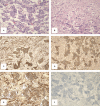Rare Case of Large Catecholamine Secreting Ganglioneuroma in an Asymptomatic Elderly Male
- PMID: 35800596
- PMCID: PMC9242669
- DOI: 10.15605/jafes.037.01.10
Rare Case of Large Catecholamine Secreting Ganglioneuroma in an Asymptomatic Elderly Male
Abstract
Ganglioneuromas (GNs) are benign tumors that originate from neural crest cells, composed mainly of mature ganglion cells. These tumors, which are usually hormonally silent, tend to be discovered incidentally on imaging tests and occur along the paravertebral sympathetic chain, from the neck to the pelvis and occasionally in the adrenal medulla. Rarely, GNs secrete catecholamines.1 Adrenal GNs occur most frequently in the fourth and fifth decades of life, whereas GNs of the retroperitoneum and posterior mediastinum are usually encountered in younger adults.2 Adrenal GNs are commonly hormonally silent and asymptomatic; even when the lesion is of substantial size.3 We report an incidentally detected asymptomatic case of an adrenal ganglioneuroma with mildly elevated urinary catecholamine levels in an elderly male. After preoperative alpha blockade, the patient underwent open right adrenalectomy. Upon microscopic examination, the right adrenal mass proved to be a ganglioneuroma, maturing type and the immunohistochemistry examination showed immunoreactivity to synaptophysin, chromogranin, and CD 56, while S100 was strongly positive at the Schwannian stroma. Following resection, catecholamine levels normalized, confirming the resected right adrenal ganglioneuroma as the source of the catecholamine excess. This case represents a rare presentation of catecholamine-secreting adrenal ganglioneuroma in the elderly.
Keywords: adrenal glands; catecholamine; ganglioneuroma.
© 2022 Journal of the ASEAN Federation of Endocrine Societies.
Conflict of interest statement
All authors certified fulfillment of ICMJE authorship criteria.
Figures



Similar articles
-
Hormone-secreting large adrenal ganglioneuroma in an adult patient: a case report and review of literature.Blood Press. 2014 Feb;23(1):64-9. doi: 10.3109/08037051.2013.796103. Epub 2013 May 27. Blood Press. 2014. PMID: 23705630 Review.
-
[Adrenal ganglioneuroma. Report of a new case].Actas Urol Esp. 2003 Mar;27(3):221-5. doi: 10.1016/s0210-4806(03)72908-8. Actas Urol Esp. 2003. PMID: 12812120 Spanish.
-
Adrenal Ganglioneuroma Presenting As Left Renal Mass.World J Oncol. 2014 Apr;5(2):90-92. doi: 10.14740/wjon783w. Epub 2014 May 6. World J Oncol. 2014. PMID: 29147384 Free PMC article.
-
Ganglioneuroma presenting as an adrenal incidentaloma: a case report.J Med Case Rep. 2014 Apr 29;8:131. doi: 10.1186/1752-1947-8-131. J Med Case Rep. 2014. PMID: 24779851 Free PMC article.
-
[Adrenal ganglioneuroma: report of a case].Hinyokika Kiyo. 1994 Jun;40(6):499-503. Hinyokika Kiyo. 1994. PMID: 8073957 Review. Japanese.
Cited by
-
The clinical spectrum of adrenal ganglioneuromas extends from severe hypertension to an asymptomatic incidentaloma; two cases and mini review of literature.Hormones (Athens). 2025 May 28. doi: 10.1007/s42000-025-00676-w. Online ahead of print. Hormones (Athens). 2025. PMID: 40434716 Review.
References
-
- Graham-Pole J, Salmi T, Anton AH, Abramowsky C, Gross S. Tumor and urine catecholamines (CATs) in neurogenic tumors. Correlations with other prognostic factors and survival. Cancer. 1983;51(5):834-9. PMID: . - PubMed
Publication types
MeSH terms
Substances
LinkOut - more resources
Full Text Sources
Medical
